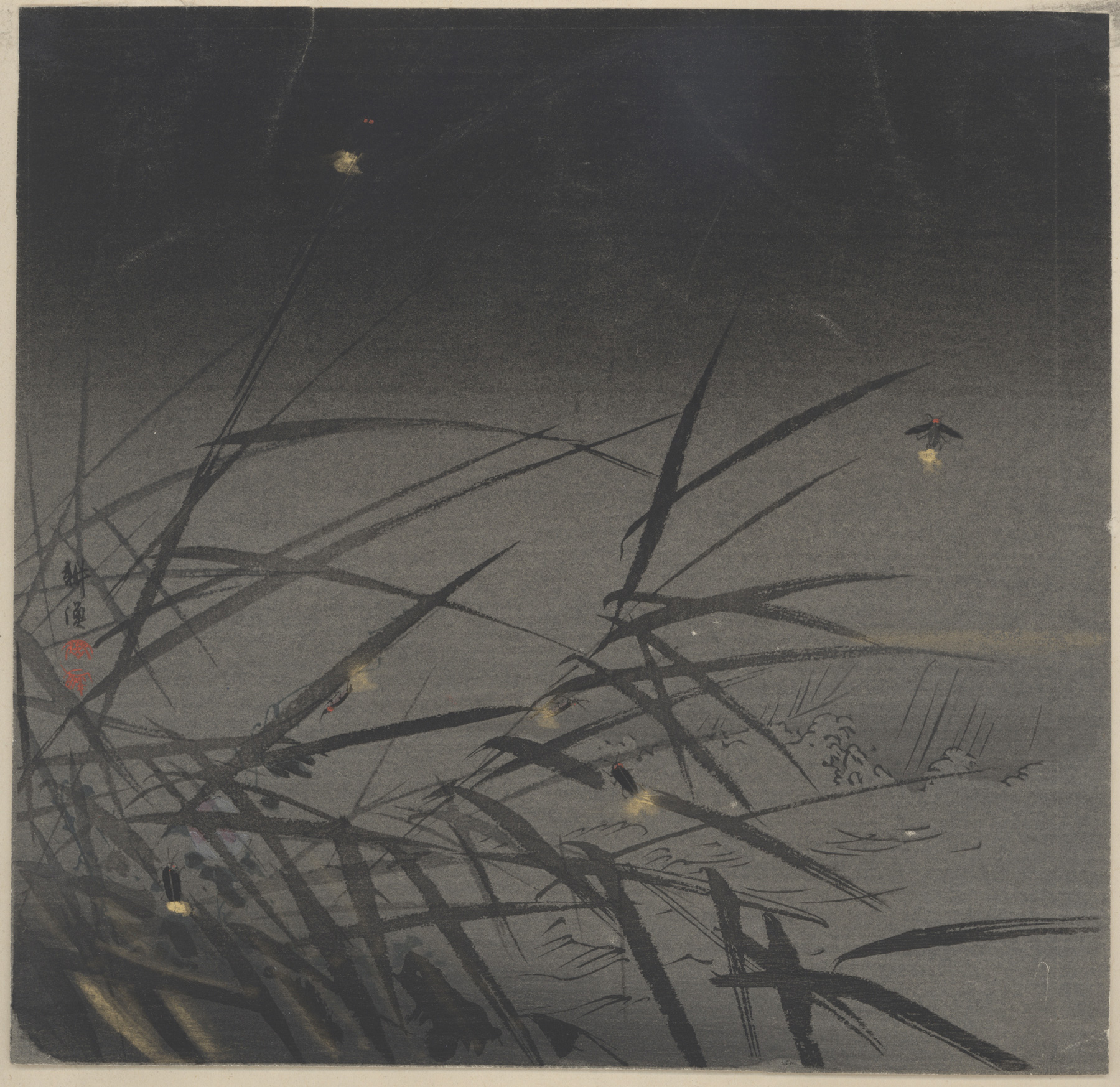About This Print
One of about fifty kacho-e (bird and flower prints) in the shikishiban (almost square) format designed by Tsukioka Kōgyo (1869-1927) for the publisher Daikokuya (Matsuki Heikichi) around the turn of last century.| This is an evocative riverine scene of fireflies (hotaru) above reeds. The theme of firelflies is a traditional one, seen, for example. in Chapter 45, "Lady of the Bridge" (Hashihime), of the Genji monogatari (Tale of Genji) by Murasaki Shikibu (act. c. 1000). The events described in that chapter take place at a country villa in Uji, southeast of Kyoto. In another interpretation, fireflies are said to represent the ghosts of the Tira (Heike) and Minamoto (Genji) warriors killed during the civil war of the late 12th century. These events are recounted in the medieval military epic, Heiki monogatari (Tale of the Heiki), which contains an account of a violent battle at Uji Bridge. These ghosts are believed to return to Uji Bridge each year, when they enact a hotaru kassen, or "firefly battle." |
Kōgyo's Shikishiban Kacho-e
Source: The Beauty of Silence: Nō and Nature Prints by Tsukioka Kōgyo (1869-1927), Robert Schaap & J. Thomas Rimer, Hotei Publishing, 2010, p. 40.| Kōgyo’s oeuvre also comprises some fifty shikishiban prints. While these works include some landscape compositions, most are illustrations of the natural world, a genre referred to asKachō-e (literally, “flower and bird pictures”). Kōgyo was one of a number of artists who designed such (export) shikishiban. His teacher Gekkō [Ogata Gekkō (1859-1920)], the lacquer artist Shibata Zeshin (1807-91), Ohara Koson [Ohara Koson (1877-1945)], and Yamamoto Shōun can all be counted among the artists enlisted by the Daikokuya to design these compositions. Many of these squarish shikishiban prints are thought to have been issued by the Daikokuya, who continually explored new avenues for print subjects and types primarily destined for the export market in the late 19th and early 20th century (a number carry a seal verso reading ‘Made in Japan,” which was required for the export to the United States). …Kōgyo’s imaginative designs for this set reflect his keen interest in flower and bird topics. His prints frequently display the same delicate treatment that is so characteristic of the work of Seitei [Watanabe Seitei, 1851-1918]. It must be pointed out, however, that Seitei’s depictions of the natural world seem more realistic. Reprints of work from this group are not uncommon. These later editions can be recognized by the black contour lines around the image and the large white borders. They are printed on very thin paper, but they also appear in an edition that is printed on heavier, denser quality paper that one would expect to find with surimono. |
Print Details
| IHL Catalog | #1714 |
| Title (Description) | untitled (Fireflies) |
| Series | |
| Artist | Tsukioka Kōgyo (1869-1927) |
| Signature |  |
| Seal | Kōhan seal, as shown above |
| Date | c. 1910 |
| Publisher | attributed to Matsuki Heikichi (Daikokuya Heikichi 大黒屋平) [Marks: pub. ref. 029] |
| Impression | excellent |
| Colors | excellent |
| Condition | good - paper imperfection upper left |
| Genre | ukiyo-e; kacho-e |
| Miscellaneous | |
| Format | shikishiban |
| H x W Paper | 9 1/2 x 9 15/16 in. (24.1 x 25.2 cm) |
| Collections This Print | British Museum 1906,1220,0.1680 |
| Reference Literature | The Beauty of Silence: Nō and Nature Prints by Tsukioka Kōgyo (1869-1927), Robert Schaap & J. Thomas Rimer, Hotei Publishing, 2010, p. 152. |


